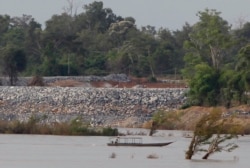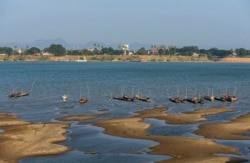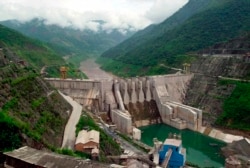As the monsoon gets underway across Indochina, farmers and fishermen are praying for rain after a lengthy drought — aggravated by climate change and dam construction.
This year the Mekong River has seen its lowest levels since record-keeping began 60 years ago.
According to the Mekong River Commission, rainfall over the Lower Mekong Basin (LMB) — encompassing parts of Myanmar, Laos, Thailand, Cambodia, and Vietnam — in May was about 68 percent lower than in May 2019.
The situation worsened in June when rainfall was about 73 percent lower than the same month in 2019 when the drought was already underway.
In its latest annual report, the MRC said improved monitoring of increasing droughts, extensive floods, and extreme weather were key issues that needed to be addressed by the Lower Mekong countries.
“Flood and drought have hit our region hard lately and require stronger regional collaboration,” MRC secretariat chief executive An Pich Hatda said, adding this included ensuring transparency, quality, and timeliness in water data sharing.
Food security has emerged as a major issue with about 70 million people depending on the Mekong for their livelihoods and nutrition. Among them is Man Ly He who has plied the waters where the Mekong River meets the Tonle Sap tributary for four decades.
He is upset with the construction of dams in northern Cambodia, Laos, and China.
“The reason why there is no fish is because of the new dams, including Stung Treng, which blocked the river flow and the water levels are going up and down three or four times a month depending on whether the dams are open or closed.
“This rainy season there has been no rain,” he added.
Scientists have also tied the drought to the climate phenomenon known as the Indian Ocean Dipole, like El Nino in the Pacific Ocean, impacting the Indian monsoon and the wet season in mainland Southeast Asia.
Unusually cooler than average sea surface temperatures in the eastern half of the Indian Ocean cause less rainfall in Southeast Asia, while warmer waters in its west cause flood in East Africa.
The Dipole is aggravated by global warming. Temperatures peaked at record highs earlier this year but have since begun a return to normal with long-range weather forecasters predicting improved rainfall patterns over the coming months.
The shifting weather patterns are also creating hardship and forcing people to change the way they live.
“My family wakes up at 2:00 a.m. to buy fish at Chhaing Chamras fish market and then we sell in the Kandal Market. We make small margins and now I buy fish because there are no fish in the river,” said Yan, a former fisherman.
“My wife works for many hours in the market while I try to do other jobs like fixing the boat. We sell from 8:00 a.m. to 11:00 a.m., then I pick up my wife.
“My family prays after lunch and we relax for a few hours then we go back to the market and sell fish again. At 8:00 p.m. come back home. Life in the Mekong is difficult.”
The drought has also taken a toll on the 850 fish species in the Lower Mekong. Many, like the Irrawaddy Dolphin and the giant catfish, are endangered. Some fish have had to be transported to deeper pools after becoming trapped in mud-puddles.
But record low water levels and plummeting fish catches have failed to move officials in Vientiane to curtail their hydro-electric dam construction, designed to turn land-locked Laos into the “battery of Asia.”
Vientiane recently announced it would proceed with its third dam across the mainstream of the Mekong at Pak Beng for $1.88 billion, following the construction of Don Sahong dam at Siphandone, part of the famed 4,000 Islands, just north of the Cambodian border.
The massive $3.8 billion dam in Xayaburi went into commercial operation in October.
Sat Smey Ror from Chroy Chang Va village has lived on a boat since she was born. She has never seen water levels this low and she blames dams for poor fish catches while noting the collapse of a dam in Laos two years ago.
“The water levels can rise quickly and when it turns dark in color, we can catch fish, maybe two or three kilograms a day. I heard that a dam collapsed when the water was too high,” she said.
Dams and climate change are a dangerous combination. Extremes in the Indian Ocean Dipole in the past occurred about once every 17.3 years, but scientists are forecasting their frequency will increase to once every 6.3 years over this century.
There are about 140 dams planned for the mainstream of the Mekong and its tributaries. Most are in China, but Beijing denies the dams are impacting downstream water levels.
A report by research company Eyes on Earth Inc. in April found China has been restricting the Mekong’s natural water flow by hoarding water through a cascade of dams.
“When drought sets in, China effectively controls the flow of the river,” Brian Eyler, the regional director of the Stimson Centre think tank said. Beijing dismissed the findings.
Despite Beijing’s denials, water levels during last year’s monsoon season reached just 2.5 meters, a third of the usual rate of 7.5 meters.
And scientists have documented the river turning blue, indicating a severe lack of the sediment needed to replenish the banks, and say soil erosion is now looming as the next threat to thousands of homes and buildings.
Ny Chann contributed to this report.








